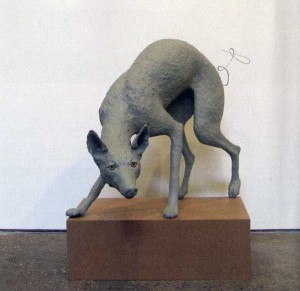For ‘Tema Celeste’ magazine

In its early days as an art center on the far west side of Manhattan, Chelsea was jokingly referred to as the Wild West. As such, it was a fitting location for The Pack, a sculptural installation of fifty life-sized coyotes by Michael Joo. Had these animals, symbols of the American West, come to life on the opening night, they would have filled the gallery with the sounds of yelping and howling. Instead, the hairless, plasticine models stayed motionless on their individual plinths, like a canine version of a Vanessa Beecroft performance. But in contrast to the snarling replicas in natural history museums, these life-sized animals are benign, the little ones even cute. In the back gallery, a second sculptural installation, provocatively titled God, featured a human figure wearing work clothes and a fur jacket lying sprawled on a bed of ice. Unlike the lively animals in the first room, the man seemed to have succumbed to the elements despite being warmly dressed. His exposed face and one hand, rendered in clear polyurethane, revealed skull and bones underneath, emphasizing his frail mortality.
The coyotes, desert loners but here assembled in an enormous pack, are survivors despite their lack of hair and skinny bodies. The man, on the other hand—ironically clad in fur—has fallen victim to icy northern temperatures. The installation’s design suggests that the ice on which he rests would gradually creep up over his body, reinforcing the idea that nature has taken control.
Expansion in all its forms produces unlikely neighbors, whether it’s pristine, white-walled galleries adjoining grimy auto body shops in Chelsea, or coyotes, bears and other animals rummaging through garbage cans in the suburbs. As Americans continue to expand their reach into the habitat of wild animals, the boundaries between civilization and the wild become blurred. Joo manages to subtly provoke viewers to question their assumptions about the mastery and adaptability of mankind as we play God with our environment.